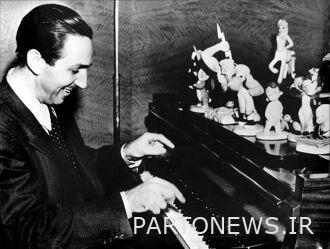Walt Disney; The one who gave classical music to cinema

Walt Disney is not only a mythical figure in the history of animated cinema, but also one of the main pioneers in the use of classical music in cinema, which has a significant role in bringing the works of great classical music to the world of animation and cinema.
Theater News Base: You may have studied music in Europe and conducted a symphony orchestra or studied other disciplines such as cinema or the media, and you may not be aware of the connection between world classical music and world animated films, and this ignorance can sometimes leave you in difficult situations to comment. Put. This report tries to solve this problem with a simple research.
Walt Disney’s first experience in making musical animations came with the “Stupid Symphony” animated series; Short animations and 75 episodes that were released between 1929 and 1939 over a decade and won 7 Academy Awards.
American musician and arranger Carl Staling was the first to propose the idea of making a harmonious, music-based animation to Walt Disney, which eventually led to the success of the successful “Stupid Symphony” animation. He also composed the music for several episodes of the series. You can watch and listen to an episode of “Music Land” from the “Stupid Symphony” animated series below:
But the story of a combination of outstanding classical and cartoon music (animation) in 1935 became serious for Walt Disney; When he was in the middle of making a series of short animations, “Stupid Symphony”, he decided to try a new initiative and made a 15-minute animation called “Band Concert”.
In this episode, “Mickey Mouse” played the role of conductor, and “Donald Duck” and “Goofy”, who were among the familiar cartoon characters of the group. Although the short film was highly acclaimed for technical reasons, it was the use of the orthodox “William Tel” by the famous Italian composer Giaccino Rossini that set the standard for the use of classical music in cartoons.
You can see parts of the humorous animation “Kestret Band” below:
After the animated “Band Concert” in 1935 and the end of the “Stupid Symphonies” series in 1939, Walt Disney decided to revive its most famous character, Mickey Mouse; But in what way?
Disney put a short animation called “The Wizard’s Apprentice” on a piece of music of the same name by Paul Dukas, and all that remained was to find a credible orchestra leader to lead the studio orchestra. Fortunately for Walt Disney, he soon met one of North America’s greatest classical musicians by chance at a restaurant.
Walt Disney certainly did not intend to dine with Leopold Stokowski, the conductor of the Philadelphia Orchestra, at a 1937 Hollywood restaurant that night. However, fate had plans for the two creative dreamers, and while talking about Walt Disney’s latest experience in combining music and animation, Disney was overwhelmed with the idea of working with Stokowski; An offer that Stokowski eagerly accepted.
Stokowski was also excited about the idea of combining classical music and cartoons. He was so interested in doing this that he conducted the orchestra for free, and after succeeding in the initial project “The Apprentice and the Wizard”, Stokowski agreed to sign a contract with Walt Disney for a feature film with the same purpose; It means combining the outstanding works of classical music with moving images.
In fact, the successful experience of the short animation “The Apprentice and the Wizard” became the cornerstone of making a feature-length animation called “Fantasy” in 1940.
On November 13, 1940, influential film critics and Hollywood celebrities gathered at the Broadway Theater in New York to watch a groundbreaking film; Walt Disney, “Fantasia,” was a mix of classical and cartoon music.
After watching the Los Angeles Times animated film “Edwin Schallet”, he called the film a courage beyond belief and a very diverse concert of visual ideas. Was made.
Shortly after the success of “Fantasia”, other greats in the world of animation such as “Michael Malti” and “Chuck Jones” also began to combine classical music and cartoons. “Fantasy” used the medium of animation, commonly known as the art of humor, and combined it with an ever-serious art (classical music) in a way that no one could have even imagined.
The 1940 animated “Fantasia” can be considered a complete homage to classical music. “Fantasia,” the third animated feature film by Walt Disney Company in the 1940s, was actually a Disney love letter to classical music that generations of children and adults alike loved. So it is not surprising that the company revisited the idea in the 38th feature animation in 2000 and in the second part of the film, bringing the “Fantasy” sequel to the cinema after 60 years.
Both films include animated images based on some of the most famous pieces of classical music. These moving images are actually what come to the mind of the animation artist when they hear this music, and these musics may inspire a different visual in each person’s mind. Some of these animations include abstract designs and others tell stories to the audience.
In the original 1940s, the music was performed by the Philadelphia Orchestra under the direction of Leopold Stokowski, and Dimes Taylor, a composer and music critic, introduced the pieces.
“Tocata and Fugue in Minor” by Johann Sebastian Bach, “The Nutcracker” by Piotr Ilyich Tchaikovsky, “The Wizard’s Apprentice” by Paul Duca, “Spring Worship” by Igor Stravinsky, respectively. “Symphony No. 5” (Shepherd or Pastoral Symphony) by “Ludwig van Beethoven”, “Dance of the Hours” by “Amilkare Punkili” and “Night on a Stone Mountain” by “Modest Mussorgsky” are famous works of classical music in the original version “Fantasia” is shown with animation inspired by it.
The animation was named by the American Film Institute as one of the top 10 animations in the history of cinema, and with a budget of $ 2.2 million, it achieved a good commercial success and sold over $ 80 million.
“Fantasia” is the most personal and daring Walt Disney project, and is one of his most overlooked works at the time of its production, and at that time there were many critics who attacked the film and described it as an unusual work.
Excerpts from Johann Sebastian Bach’s “Tocata and Fugue in Minor” and its animation can be seen in “Fantasy” (1940):
After several unsuccessful attempts to make a sequel to the “Fantasia” animation, Disney itself decided to implement the idea, and 60 years after the first part, in 2000, the second part of the “Fantasia” animated film was released. The film also received positive reviews from critics, although it did not succeed in the first part.
In this part, “Symphony No. 5” by “Ludwig van Beethoven”, “Roman Kajas” by “Otorino Raspigi”, “Spring Worship” by “Igor Stravinsky”, “Blue Rhapsody” by “George Gershwin”, “Piano Concerto 2” “Dmitry Shostakovich”, “Animal Carnival” by Kami Saint-Saens, “Glory and Situation” by Edward Elgar, “The Wizard’s Apprentice” by Paul Duca, “Fire Bird” by Igor Stravinsky, ” A Night on a Rocky Mountain “by Modest Mussorgsky; There were eight pieces by the greats and classical musicians, performed by the Philadelphia Orchestra in the original version of “Fantasia”, respectively, followed by an animation tailored to the mood of the music.
Below is a portion of Beethoven’s Symphony No. 5 and the animation made to match it in “Fantasy” (2000):
In 1946, during World War II, when many Disney employees were drafted into the military, Walt Disney created a collection of music-based short animations in the form of a feature-length animation called “Mine” to keep its feature films alive. Released “Music” and in 1959 made the famous animation “Beautiful and Sleeping” based on the most famous fins made by the great Russian composer Pyotr Ilyich Tchaikovsky; Yes, an animation adaptation of classical music!
Walt Disney’s legacy of using classical music in animation has been taken over by other animation studios, including the use of Johann Strauss’s “Blue Danube” in “SpongeBob SquarePants” by Grand Waltz. “Frederick Chopin” in the animation “Marsha and the Bear”, the classic song number 3 by Frances Schubert in the animation “My Life as a MacDonald”, Beethoven’s Symphony No. 5 in the series “The Simpsons”, etc. can be mentioned.
The use of classical works is not limited to animations, and over the years, great directors have used world-class works of classical music to create a deeper feeling in the audience, such as: “Melancholia” includes a piece of music by “Richard “Wagner”, “Strong Black” with “Tchaikovsky”, “Cookie Orange” (Beethoven Symphony No. 9), “Now the Apocalypse” (Richard Wagner), “Angry Cow” (Pietro Mascani), “Blood will rise” (Johannes Brans), “The Short Encounter” (Sergei Rachmaninoff), “2001: A Space Odyssey” (Richard Strauss), “The Beautiful Woman” (Giuseppe Verdi), “Amadeus” (Mozart), “Behind the Chandelier” (Frederic Chopin) ), “Baghdad Cafe” (Johann Sebastian Bach) and …
///.

